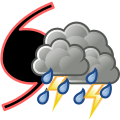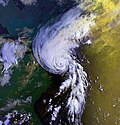The Tropical Cyclones Portal

A tropical cyclone is a storm system characterized by a large low-pressure center, a closed low-level circulation and a spiral arrangement of numerous thunderstorms that produce strong winds and heavy rainfall. Tropical cyclones feed on the heat released when moist air rises, resulting in condensation of water vapor contained in the moist air. They are fueled by a different heat mechanism than other cyclonic windstorms such as Nor'easters, European windstorms and polar lows, leading to their classification as "warm core" storm systems. Most tropical cyclones originate in the doldrums, approximately ten degrees from the Equator.
The term "tropical" refers to both the geographic origin of these systems, which form almost exclusively in tropical regions of the globe, as well as to their formation in maritime tropical air masses. The term "cyclone" refers to such storms' cyclonic nature, with anticlockwise rotation in the Northern Hemisphere and clockwise rotation in the Southern Hemisphere. Depending on its location and intensity, a tropical cyclone may be referred to by names such as "hurricane", "typhoon", "tropical storm", "cyclonic storm", "tropical depression" or simply "cyclone".
Types of cyclone: 1. A "Typhoon" is a tropical cyclone located in the North-west Pacific Ocean which has the most cyclonic activity and storms occur year-round. 2. A "Hurricane" is also a tropical cyclone located at the North Atlantic Ocean or North-east Pacific Ocean which have an average storm activity and storms typically form between May 15 and November 30. 3. A "Cyclone" is a tropical cyclone that occurs in the South Pacific and Indian Oceans.
Selected named cyclone -
Hurricane Fabian was a powerful tropical cyclone that impacted Bermuda in early September during the 2003 Atlantic hurricane season. It was the sixth named storm, fourth hurricane, and first major hurricane of the season, developed from a tropical wave in the tropical Atlantic Ocean on August 25. It moved west-northwestward under the influence of the subtropical ridge to its north, and steadily strengthened in an area of warm sea surface temperatures and light wind shear. The hurricane attained a peak intensity of 145 mph (233 km/h) on September 1, and it slowly weakened as it turned northward. On September 5, Fabian made a direct hit on Bermuda with wind speeds of over 120 mph (190 km/h). After passing the island, the hurricane turned to the northeast, and became extratropical on September 8, before dissipating two days later.
Fabian was the strongest hurricane to hit Bermuda since Hurricane Arlene in 1963. It was both the most damaging and the first hurricane to cause a death on the island since 1926. The hurricane's powerful winds resulted in moderate damage and destroyed roofs throughout the island. A strong storm surge associated with the hurricane killed four people crossing a causeway on Bermuda, temporarily closing the only link between two islands. The endangered Bermuda petrel, better known as the cahow, was threatened by the hurricane, which destroyed ten nests, although volunteer work transported the species to a safer location. Strong swells resulted in damage in northern Puerto Rico and the Dominican Republic, and also caused four people to drown along the United States' Atlantic coast. In all, Fabian caused around US$300 million in damage and eight deaths. (Full article...)
Selected article -
The 1970 Bhola cyclone (also known as the Great Cyclone of 1970 or simply the Bhola Cyclone) was the deadliest tropical cyclone on record, as well as one of the deadliest humanitarian disasters ever recorded. It struck East Pakistan (present-day Bangladesh) and India's West Bengal on 12 November 1970. At least 300,000 people died in the storm, possibly as many as 450,000, primarily as a result of the storm surge that flooded much of the low-lying islands of the Ganges Delta. Bhola was the sixth and strongest cyclonic storm of the 1970 North Indian Ocean cyclone season.
The cyclone formed over the central Bay of Bengal on 8 November and traveled northward, intensifying as it did so. It reached its peak with winds of 185 km/h (115 mph) on 10 November, and made landfall on the coast of East Pakistan on the following afternoon. The storm surge devastated many of the offshore islands, wiping out villages and destroying crops throughout the region. In the most severely affected upazila Tazumuddin, over 45% of the population of 167,000 were killed by the storm. (Full article...)
Selected image -

Selected season -

The 1988 Atlantic hurricane season was a near average season that proved costly and deadly, with 15 tropical cyclones directly affecting land. The season officially began on June 1, 1988, and lasted until November 30, 1988, although activity began on May 30 when a tropical depression developed in the Caribbean. The June through November dates conventionally delimit the period of each year when most tropical cyclones form in the Atlantic basin. The first cyclone to attain tropical storm status was Alberto on August 8, nearly a month later than usual. The final storm of the year, Tropical Storm Keith, became extratropical on November 24. The season produced 19 tropical depressions of which 12 attained tropical storm status. One tropical storm was operationally classified as a tropical depression but was reclassified in post-analysis. Five tropical cyclones reached hurricane status of which three became major hurricanes reaching Category 3 on the Saffir–Simpson scale. It was later surpassed 34 years later until the 2022 Atlantic hurricane season, to have multiple Atlantic-Pacific crossover storms.
There were two notable cyclones of the season, the first one being Hurricane Gilbert, which at the time was the strongest Atlantic hurricane on record. The hurricane tracked through the Caribbean Sea and the Gulf of Mexico and caused devastation in Mexico and many island nations, particularly Jamaica. Its passage caused $2.98 billion in damage (1988 USD) and more than 300 deaths, mostly in Mexico. The second one was Hurricane Joan, which struck Nicaragua as a Category 4 hurricane and caused about US$1.87 billion in damage and more than 200 deaths. The hurricane crossed into the eastern Pacific Ocean and was reclassified as Tropical Storm Miriam. Hurricane Debby also successfully crossed over, becoming Tropical Depression Seventeen-E, making the 1988 season the first on record in which more than one tropical cyclone has crossed between the Atlantic and Pacific basins intact. (Full article...)
Related portals
Currently active tropical cyclones

Italicized basins are unofficial.
- East and Central Pacific (2025)
- No active systems
- North Indian Ocean (2025)
- No active systems
- Mediterranean (2025–26)
- No active systems
- South-West Indian Ocean (2025–26)
- No active systems
- Australian region (2025–26)
- No active systems
- South Pacific (2025–26)
- No active systems
- South Atlantic (2025–26)
- No active systems
Last updated: 10:21, 18 August 2025 (UTC)
Tropical cyclone anniversaries

August 17,
- 1969 - Hurricane Camille made landfall on the Mississippian coastline near Waveland with 305 km/h (190 mph) winds, the second-strongest maximum sustained wind speed at landfall of any Atlantic hurricane to strike the contiguous United States. Camille killed over 250 people and caused $1.4 billion in damage.
- 2013 - Tropical Depression Maring (pictured) affects the Philippines by enhancing the southwest monsoon killing 27 people with ₱690 million (US$15.4 million) before intensifying into a tropical storm.

August 18,
- 1983 - Hurricane Alicia made landfall as a Category 3 hurricane near Galveston, Texas. Alicia killed 21 people and caused $2 billion worth of damage.
- 2008 - Tropical Storm Fay (pictured) makes landfall over in Florida where it reached peak intensity overland. Moreover 21 people have perished over in America.

August 19,
- 1972 - Hurricane Celeste passes northeast of Johnston Island, surpassing records such as the highest wind gust and lowest pressure within the island.
- 1991 - Hurricane Bob (pictured) reached its peak intensity with 180 km/h (115 mph) winds off the east coast of the United States and caused $1.5 billion in damage to New England.
Did you know…




- …that the Joint Typhoon Warning Center considers that Typhoon Vera (pictured) of 1986 is actually two distinct systems, formed from two separated low-level circulations?
- …that Cyclone Freddy (track pictured) in 2023 was the longest-lasting tropical cyclone recorded?
- …that the typhoons of 2024—Yinxing, Toraji, Usagi, and Man-yi (pictured)—made history as the first recorded instance since 1951 of four tropical cyclones coexisting in November?
- …that Hurricane Otis (pictured) in 2023 was the first Pacific hurricane to make landfall at Category 5 intensity and surpassed Hurricane Patricia as the strongest landfalling Pacific hurricane on record?
General images -

The 2004 Atlantic hurricane season was notable as one of the deadliest and most costly Atlantic hurricane seasons on record. It officially began on June 1, 2004, and ended on November 30, although storm activity continued into December. This timeline documents tropical cyclone formations, strengthening, weakening, landfalls, extratropical transitions, as well as dissipations. The timeline includes information which was not operationally released, meaning that information from post-storm reviews by the National Hurricane Center, such as information on a storm that was not operationally warned upon, has been included.
This season had 16 tropical depressions, of which, 15 became named storms. Of these, 9 strengthened into hurricanes with 6 intensifying into major hurricanes. The most noteworthy storms for the season were the five named storms that made landfall in the U.S. states of Florida and Alabama, three of them with at least 115 mph (185 km/h) sustained winds (major hurricane strength): Tropical Storm Bonnie, Charley, Frances, Ivan, and Jeanne. This is the only time in recorded history that four hurricanes affected the U.S. State of Florida although one of the four, Ivan, brought hurricane-force winds to the state without making a landfall there. (Full article...)
Topics
Subcategories
Related WikiProjects
WikiProject Tropical cyclones is the central point of coordination for Wikipedia's coverage of tropical cyclones. Feel free to help!
WikiProject Weather is the main center point of coordination for Wikipedia's coverage of meteorology in general, and the parent project of WikiProject Tropical cyclones. Three other branches of WikiProject Weather in particular share significant overlaps with WikiProject Tropical cyclones:
- The Non-tropical storms task force coordinates most of Wikipedia's coverage on extratropical cyclones, which tropical cyclones often transition into near the end of their lifespan.
- The Floods task force takes on the scope of flooding events all over the world, with rainfall from tropical cyclones a significant factor in many of them.
- WikiProject Severe weather documents the effects of extreme weather such as tornadoes, which landfalling tropical cyclones can produce.
Things you can do
 |
Here are some tasks awaiting attention:
|
Wikimedia
The following Wikimedia Foundation sister projects provide more on this subject:
-
Commons
Free media repository -
Wikibooks
Free textbooks and manuals -
Wikidata
Free knowledge base -
Wikinews
Free-content news -
Wikiquote
Collection of quotations -
Wikisource
Free-content library -
Wikiversity
Free learning tools -
Wikivoyage
Free travel guide -
Wiktionary
Dictionary and thesaurus






































